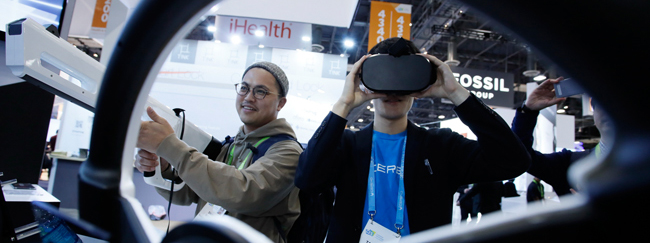
Last year marked the 50th anniversary of CES, the largest global gathering of technology and innovation, with over 4,000 exhibitors spanning across 2.6 million square feet of exhibition space. Over 180,000 industry professionals attended in 2017, 58,000 from outside the US, making it truly a record-breaking event.
In simpler terms, CES is unlike any other trade show. Since its inaugural year in 1967, when the show took place in New York City versus Las Vegas, it has set the bar for excellence in technology and innovation, and since then, has grown exponentially.
So, to say that CES 2018 had some big shoes to fill would be an understatement. How would CES 2018 kick off the next 50 years in breakthrough technologies and next-generation innovations? Despite the torrential downpour (first rain in Las Vegas in 116 days) and a two-hour power blackout the following day, CES 2018 was an absolute hit.
With a strong emphasis on Smart Cities, there were clear implications for the out of home (OOH) industry and multiple brands gave us a glimpse of life in the future.
Transportation, Smarter Cities, and OOH
The way we get around is going to drastically change in the next decade. Some of the world’s largest companies are investing heavily in changing how people travel. Virgin is projecting to have three Hyperloop, electric propulsion, high speed, train-like transportation systems in service by 2021 and is continuing to expand its efforts throughout the US and Middle East. Mercedes-Benz unveiled the Smart Vision EQ which completely embodies the idea of autonomous. The vehicle lacks a steering wheel and pedals and provides the driver with a fully “hands-off” experience.
The partnership is powered by its mobility services platform and can provide users with a constant flow of data that includes efficient routes and seamless transitions between vehicles, public transportation and payment nodes, changing the way we’ll move for the better.
To improve the everyday journey, and in collaboration with Qualcomm, Ford’s Cellular Vehicle to Everything (C-V2X) technology has the potential to help cities around the world create safer, more capable infrastructure and connect vehicles to a larger communications system. It is these such mobility networks that are the key component in the growth and sustainability of smart cities.
As a result, cities can reclaim space that was once solely used for cars and transform the street into a space for people that offers a place to stop, consume and connect. This presents a prime opportunity for the OOH industry to simultaneously expand its efforts and continue to play a key role in the growth of smart cities.
Imagine city centers, void of any vehicles, focused on free moving people and connected through dynamic OOH inventory, which leverages real-time data collected from sensors built into static structures, connected objects or more complex systems like Ford’s C-V2X vision.
The underlying commodity for the OOH industry is the sheer amount of data that will be available.
It is the ability to leverage real-world activities, happening in both a physical and digital space, in real-time, to create a memorable consumer connection. With so much free-flowing data available, the idea of following the consumer journey has never been more real. But the value proposition is not limited to just hyper-targeted messaging; smart cities will influence how OOH media is planned and bought. The goal is to minimise ad waste and maximise effectiveness by leveraging data to pinpoint how your target audience moves throughout the day and reach them at the right time and place.
As leaders and politicians are urged to innovate, improve the quality of life and increase profitability, cities around the world are quickly adopting the smart city initiative. As Ford showcased, there are clear transportation and infrastructure benefits, and continued investments from both the public and private sectors are being made to drive this movement forward.
New York City has seen this first hand with multiple street closures, converted to pedestrian areas, and supplemented with multi-functioning and connected OOH inventory. It is estimated that around three million people are moving to cities every week and approximately 54% of people worldwide now live in cities, up from 30% in 1950. As cities continue to grow and innovate, brands will need to compete even harder to grab the attention of their target audience, and it will be up to the OOH industry to help make that real-world and custom connection possible.
Originally posted to Mediatel.
Published: January 18, 2018